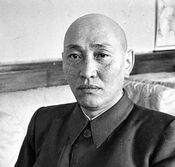Chandan Republican Revolution: Difference between revisions
No edit summary |
mNo edit summary |
||
| Line 2: | Line 2: | ||
{{for|the conflict during the [[Great War (Kylaris)|Great War]]|Chandan War of Independence}}{{for|the conflict between the factions of the People's Liberation Army of Chanda|Chandan National Revolution}} | {{for|the conflict during the [[Great War (Kylaris)|Great War]]|Chandan War of Independence}}{{for|the conflict between the factions of the People's Liberation Army of Chanda|Chandan National Revolution}} | ||
[[File:Wu Khar.jpg|175px|thumb|right|[[Wu Khar]], considered the main architect of the Republican Revolution.]] | [[File:Wu Khar.jpg|175px|thumb|right|[[Wu Khar]], considered the main architect of the Republican Revolution.]] | ||
The '''Republican Revolution''' ([[Chandan language|Chandan]] '''අයමගඛග උලුඛඛචිලික ධුඛගල''', ''Aymagsaga Uluschilik Husgal'') is a term used to refer to the {{wp|regime change}} that | The '''Republican Revolution''' ([[Chandan language|Chandan]] '''අයමගඛග උලුඛඛචිලික ධුඛගල''', ''Aymagsaga Uluschilik Husgal'') is a term used to refer to the {{wp|regime change}} that saw [[Chanda]] transition from the [[West Shalegho Commandery]] to the [[Chanda|Republic of Chanda]], under the direction of the [[Chandan Socialist Unity Front]]. | ||
It is generally considered to have started with the outbreak of the [[Chandan National Revolution]], in March 1949. The era saw the adoption of [[Birlikism]] as a national ideology, the construction of a national identity by the state, and the creation and development of state institutions. Historians disagree on the exact date the revolution was completed; while the official announced the end of the Revolution with the [[Declaration of the Republic]] in April 1951, many historians agree that the movement behind the Revolution continued for years after. At its latest, the Revolution is said to have ended by the end of the decade, during the [[Satrian Wars and conflicts|Second Satrian War]]. | It is generally considered to have started with the outbreak of the [[Chandan National Revolution]], in March 1949. The era saw the adoption of [[Birlikism]] as a national ideology, the construction of a national identity by the state, and the creation and development of state institutions. Historians disagree on the exact date the revolution was completed; while the official announced the end of the Revolution with the [[Declaration of the Republic]] in April 1951, many historians agree that the movement behind the Revolution continued for years after. At its latest, the Revolution is said to have ended by the end of the decade, during the [[Satrian Wars and conflicts|Second Satrian War]]. | ||
Revision as of 03:56, 1 April 2021

The Republican Revolution (Chandan අයමගඛග උලුඛඛචිලික ධුඛගල, Aymagsaga Uluschilik Husgal) is a term used to refer to the regime change that saw Chanda transition from the West Shalegho Commandery to the Republic of Chanda, under the direction of the Chandan Socialist Unity Front.
It is generally considered to have started with the outbreak of the Chandan National Revolution, in March 1949. The era saw the adoption of Birlikism as a national ideology, the construction of a national identity by the state, and the creation and development of state institutions. Historians disagree on the exact date the revolution was completed; while the official announced the end of the Revolution with the Declaration of the Republic in April 1951, many historians agree that the movement behind the Revolution continued for years after. At its latest, the Revolution is said to have ended by the end of the decade, during the Second Satrian War.